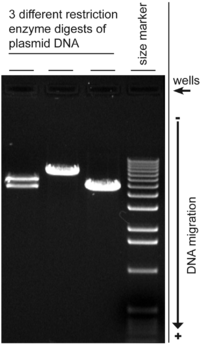
Photo from wikipedia
Oleogelation has recently emerged as a subject of growing interest among industrial and academic researchers. One of the main concerns when working with oleogels is finding the ideal food-grade oleogelators… Click to show full abstract
Oleogelation has recently emerged as a subject of growing interest among industrial and academic researchers. One of the main concerns when working with oleogels is finding the ideal food-grade oleogelators with right functionalities and universal applications. Identifying synergistic combinations of well-known food ingredients could possibly help us overcome this issue. In this work we have identified for the first time, that the combination of monoglycerides (MGs) and phytosterols (PS) at certain ratios leads to the formation of mixed component gels that are better than either of the mono component gels. Oleogels were investigated in terms of their rheological properties, crystallization aspects, and microstructural attributes. Three different types of MGs were combined with commercial-grade PS in different ratios to structure sunflower oil into viscoelastic gels. Polarized light microscopy images of all the samples revealed the formation of three-dimensional network of entangled crystals, leading to the physical trapping of liquid oil within the interspace structures. Amplitude sweeps showed that the gels formed from these oleogelators had predominantly solid-like structure (G′ > G″). The mixtures of MGs:PS at 8:2 ratio showed a promising combination as the G′LVR obtained was much higher than gels prepared by using individual components. Based on the crystallization and microstructure studies, it can be speculated that the presence of PS assisted in disintegrating the crystalline clusters and flocs of MGs crystals resulting in gels with better rheological properties compared to mono component oleogels. Practical applications: Oleogelation has emerged as a subject of growing interest in the last couple of years fuelled both by real industrial needs and curiosity for fundamental research among academic researchers. However, one of the main bottlenecks in commercial application of this approach is the lack of ideal food-grade oleogelators. In this work we have identified for the first time, the synergistic interactions among monoglycerides and phytosterols which leads to the formation of mixed component gels. The resultant gel from that combination can later be used as either an alternative to saturated fat or delivery of functional ingredients. Saturated fat replacement in margarine or butter formulation could be the main application of this oleogel. This is due to the fact that both of the oleogelators used to structure sunflower oil in this research have been used widely in food application. In addition, oleogelators used to structure sunflower oil are available widely in the market. Oleogelation has recently emerged as a subject of growing interest among industrial and academic researchers. One of the main concerns when working with oleogels is finding the ideal food-grade oleogelators with right functionalities and universal applications. Identifying synergistic combinations of well-known food ingredients could possibly help us overcome this issue. In this work we have identified for the first time, that the combination of monoglycerides (MGs) and phytosterols (PS) at certain ratios leads to the formation of mixed component gels that are better than either of the mono component gels. Oleogels were investigated in terms of their rheological properties, crystallization aspects, and microstructural attributes. Three different types of MGs were combined with commercial-grade PS in different ratios to structure sunflower oil into viscoelastic gels. Polarized light microscopy images of all the samples revealed the formation of three-dimensional network of entangled crystals, leading to the physical trapping of liquid oil within the interspace structures. Amplitude sweeps showed that the gels formed from these oleogelators had predominantly solid-like structure (G′ > G″). The mixtures of MGs:PS at 8:2 ratio showed a promising combination as the G′LVR obtained was much higher than gels prepared by using individual components. Based on the crystallization and microstructure studies, it can be speculated that the presence of PS assisted in disintegrating the crystalline clusters and flocs of MGs crystals resulting in gels with better rheological properties compared to mono component oleogels.
Journal Title: European Journal of Lipid Science and Technology
Year Published: 2017
Link to full text (if available)
Share on Social Media: Sign Up to like & get
recommendations!